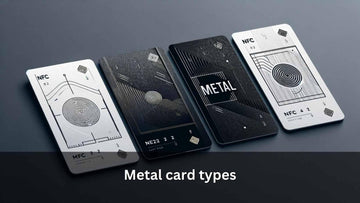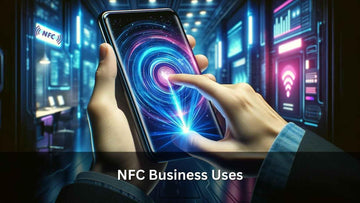Tap into the Future: Revolutionizing Restaurant Experiences with NFC Technology

Contents
- 1- Introduction
- 2- NFC and QR Codes: A Digital Menu Revolution
- 3- Simplifying Service: NFC for Table Service and Reviews
- 4- Effortless Connectivity: NFC for Wi-Fi Access
- 5- Case Study: Ishbilia Restaurant's Success with NFC
- 6- Implementing NFC Technology for Restaurants
- 7- Conclusion: The Future of Dining
Introduction
In the rapidly evolving landscape of restaurant technology, Near Field Communication (NFC) is emerging as a pivotal tool in enhancing customer experiences and operational efficiency. This innovative technology, which enables two devices to exchange data when they are brought into close proximity, is finding myriad applications across various sectors, with the restaurant industry standing out as a prime beneficiary. Alongside QR codes, NFC is revolutionizing the way customers interact with menus, make payments, and connect with the digital offerings of their favorite dining spots.
This article aims to delve into the transformative impact of NFC and QR codes within restaurants, highlighting their role in not only modernizing the dining experience but also in simplifying operational workflows and bolstering customer engagement. Through an exploration of practical applications and real-world examples, we'll uncover the potential of NFC technology to set new standards in the hospitality industry, making dining out a more seamless, interactive, and enjoyable experience for all.
NFC and QR Codes: A Digital Menu Revolution
The integration of NFC and QR codes into restaurant services marks a significant shift from traditional menu browsing to a dynamic, digital experience. NFC technology offers a touchless, efficient method for accessing menus and placing orders with a simple tap of a smartphone, catering especially to newer phone models equipped with NFC capabilities. Meanwhile, QR codes bridge the gap for devices without NFC, ensuring that the digital transition is inclusive, allowing customers to scan codes with their camera to view menus online.
This dual approach not only caters to a broader range of technological preferences but also significantly reduces the need for physical contact—a change that has become increasingly important in post-pandemic dining environments. Customers can enjoy the convenience of exploring menu options, placing orders, and even making payments without the need to handle physical menus or interact closely with staff, thereby enhancing safety, speed, and satisfaction in their dining experience.
Simplifying Service: NFC for Table Service and Reviews
NFC technology extends beyond digital menus, playing a crucial role in streamlining table service and amplifying customer feedback mechanisms. By embedding NFC tags in tables or other accessible spots within a restaurant, customers can effortlessly request service, place orders, or call for the bill with a simple tap of their smartphone.
This seamless interaction not only enhances the dining experience by minimizing wait times and improving service efficiency but also empowers restaurants to prompt customers for immediate feedback before they leave. By linking NFC interactions to review platforms like Google Reviews and TripAdvisor, restaurants can encourage satisfied customers to share their experiences online, directly from their table. This immediate call to action for feedback can significantly increase the quantity and quality of online reviews, boosting a restaurant's online visibility and reputation. The benefits of such direct and instant feedback mechanisms are twofold: they provide valuable insights for service improvement and elevate a restaurant's profile in a competitive digital landscape.
Effortless Connectivity: NFC for Wi-Fi Access
Restaurants are increasingly leveraging NFC technology to offer effortless Wi-Fi connectivity to their patrons, significantly enhancing the customer experience by eliminating common hurdles associated with online access. By integrating NFC tags within their premises, restaurants enable customers to instantly connect to the Wi-Fi network without the hassle of manually typing in passwords.
For iPhone users, this process is as simple as scanning a QR code displayed on the NFC tag, which automatically prompts the Wi-Fi login without the need for password entry. Android users enjoy a similar level of convenience; a simple tap on the NFC-enabled item connects their device to the network instantly.
This streamlined approach not only fosters a frictionless digital environment for customers but also positions the restaurant as a tech-savvy establishment committed to customer satisfaction. The dual-use of NFC tags and QR codes ensures that all customers, regardless of their device's capabilities, can access Wi-Fi effortlessly, thereby enhancing their dining experience and encouraging longer stays and increased engagement with the restaurant’s digital offerings.
NFC in Action: Tools for Engagement
NFC technology in restaurants serves as a powerful tool for enhancing customer engagement through various innovative items, each offering unique opportunities for interaction and service improvement. Here's how these items can be utilized effectively:
Table Talkers: can be strategically placed on each table or positioned in the lobby, serving as multifunctional tools that significantly enhance the dining experience. Embedded with NFC technology, these tags cater to a range of customer needs with just a single tap on a smartphone. Whether it’s for accessing the digital menu, connecting to the restaurant’s Wi-Fi, or navigating to a platform to leave a review, NFC tags simplify these interactions, making them more accessible and efficient for customers.
By situating these tags both at individual tables and key communal areas like the lobby, restaurants ensure that every patron, from the moment they step in, has everything they need right at their fingertips, thereby elevating the overall customer experience.
PVC Cards: Similar to table talkers in functionality, PVC cards can be carried by restaurant staff or placed strategically around the establishment. They can be programmed to encourage customers to leave reviews, access the menu, or even receive special offers. Additionally, PVC cards can be distributed outside the restaurant by staff to potential customers, inviting them to experience the dining environment and special promotions.
Sticker PVC Cards: These are adhesive-backed and can be placed on tables, menus, or anywhere within the restaurant. While they offer the same functionalities as regular PVC cards, including menu access, Wi-Fi connectivity, and review prompts, their adhesive nature means they are not meant to be moved once placed. However, like other NFC items, they can be encoded and re-encoded multiple times to update their functions or promotions.
NFC Tags & Key Fobs: The most versatile of the NFC options, these small tags can be integrated into almost any part of the restaurant's physical setup. From embedding them into coasters to placing them at the entrance for immediate Wi-Fi access or promotional content, NFC tags offer a discreet yet powerful means to engage customers. Their re-programmable nature allows for continuous updates, ensuring that the content remains fresh and relevant.
Notably, NFC tags stand out for their customization flexibility, accommodating large quantity orders of 200 or more, tailored to specific promotional or operational needs. This feature contrasts with other mentioned items, such as table talkers or PVC cards/ PVC cards sticker, which are available for purchase in any quantity, even as single items, providing a scalable solution for businesses of all sizes.
Each of these NFC-enabled items offers a distinct avenue for enhancing the customer experience, from simplifying actions like connecting to Wi-Fi or ordering food, to engaging customers through feedback and promotional activities. By adopting a mix of these tools, restaurants can create a highly interactive and enjoyable dining environment that encourages customer participation and loyalty.
Case Study: Ishbilia Restaurant's Success with NFC
Ishbilia Restaurant in the UK presents a compelling case study on the effective implementation of NFC technology to enhance dining experiences and operational efficiency. Utilizing NFC-enabled items like PVC cards, the restaurant embarked on a journey to digitally transform its customer service and management processes. By integrating these NFC items with the nfctagify software, Ishbilia was able to meticulously track employee interactions with customers, seamlessly gather customer reviews, and adeptly manage restaurant traffic.
The introduction of NFC technology brought about a suite of tangible benefits. Firstly, it significantly increased operational efficiency, allowing staff to quickly respond to customer needs and manage table turnover more effectively. Secondly, customer satisfaction soared as patrons enjoyed a more interactive and streamlined dining experience, from ordering to leaving feedback. Finally, the data collected through NFC interactions provided Ishbilia with invaluable insights into staff performance, highlighting areas of excellence and opportunities for further training. Similarly, customer preferences and feedback gathered via NFC were instrumental in refining the menu and service offerings to better meet patron expectations.
Ishbilia Restaurant's success story underscores the transformative potential of NFC technology in the hospitality industry, showcasing how it can foster a more efficient, satisfying, and insightful dining environment.


Implementing NFC Technology for Restaurants
For restaurants eager to embrace NFC technology, the initial step involves selecting the right NFC items tailored to your specific needs—be it table talkers, PVC cards, or NFC tags for diverse applications like menus, Wi-Fi access, or customer feedback. Upon choosing your NFC products, integration with your operational systems is crucial. This includes setting up software for tracking interactions and analyzing customer data, which is essential for refining services and enhancing the dining experience.
A critical aspect of implementation is customizing your NFC items to align with your brand. When placing your order on the supplier's website, you have the opportunity to personalize these items with your restaurant's logo, designs, or even QR codes. This customization process is typically facilitated through a Form page provided by the supplier, where you can upload your design elements. This step not only ensures that your NFC items are effective in their functional role but also serve as an extension of your brand identity, contributing to a cohesive and engaging customer experience.
Conclusion: The Future of Dining
NFC technology holds the transformative power to redefine the dining experience, bridging the gap between digital convenience and physical hospitality. By facilitating seamless interactions—from menu browsing and Wi-Fi connectivity to instant feedback and payment processes—NFC enhances customer satisfaction and streamlines restaurant operations.
Its capacity for gathering actionable insights and personalizing customer experiences positions NFC as a catalyst for operational efficiency and business growth. As the restaurant industry continues to navigate the digital age, adopting NFC technology emerges as a strategic move towards future-proofing services. Restaurants that integrate NFC into their digital transformation strategies not only set new standards for customer engagement but also embrace a future where dining is an effortlessly connected experience.
We at NFC Tagify provide all sort of NFC Solutions or you may contact us: Tel. 01600800080, Email: info@nfctagify.com









